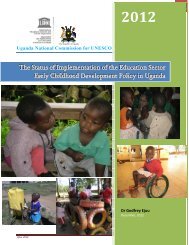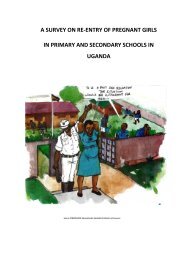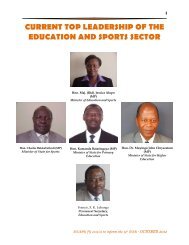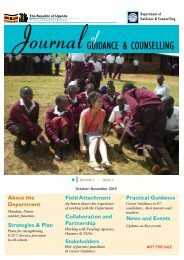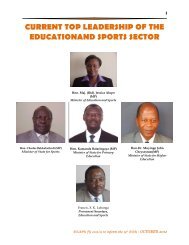Edited Newsletter.pub - Ministry Of Education and Sports
Edited Newsletter.pub - Ministry Of Education and Sports
Edited Newsletter.pub - Ministry Of Education and Sports
Create successful ePaper yourself
Turn your PDF publications into a flip-book with our unique Google optimized e-Paper software.
EDUCATION AND SPORTS<br />
MANAGEMENT INFORMATION<br />
SYSTEMS (EMIS)<br />
SPECIAL<br />
POINTS OF<br />
INTEREST:<br />
• Access indicators<br />
for <strong>Education</strong><br />
in<br />
Ug<strong>and</strong>a<br />
• Equity -<br />
Gender Parity<br />
Index<br />
• <strong>Education</strong><br />
Quality Indicators<br />
INSIDE<br />
THIS ISSUE:<br />
New Dev’t 2<br />
What’s New 2<br />
Comments 2<br />
Did You<br />
Know<br />
Did You<br />
Know<br />
Food for<br />
Thought<br />
3<br />
4<br />
5<br />
EMIS <strong>Newsletter</strong><br />
V O L U M E 1 , I S S U E 1<br />
Access Indicators for <strong>Education</strong> in Ug<strong>and</strong>a<br />
Ever since the inception of Universal<br />
Primary <strong>Education</strong> (UPE)<br />
in Ug<strong>and</strong>a, the enrolment in the<br />
primary schools has been increasing<br />
steadily. With reference<br />
to the EMIS Statistical Yearly<br />
Abstracts, the enrolment was<br />
2,636,409 in 1995 <strong>and</strong> 3,068,625<br />
in 1996. When UPE was introduced<br />
in 1997, enrolment increased<br />
to 5,806,386 almost<br />
doubling the total enrolment.<br />
Ten years down the road, the<br />
enrolment has tripled to<br />
7,414,880 in 2007, of which<br />
3,718,117 are male <strong>and</strong> 3,696,763<br />
are female indicating that the<br />
gender parity index (GPI) gap has<br />
also been reduced. The Gross<br />
Enrolment Ratio (GER) for the<br />
primary sector has also been on<br />
a good trend for Ug<strong>and</strong>a. In<br />
2000, it was 128.29%, <strong>and</strong> there<br />
Over the years the debate between<br />
girls <strong>and</strong> boys going to<br />
school has been a very contentious<br />
issue especially in rural<br />
Ug<strong>and</strong>a. The rural population<br />
normally deny their girls from<br />
going to school at the expense of<br />
marriage, domestic work. In<br />
addition fees issues. where boys<br />
are preferred to girls when it<br />
comes to paying school fees. The<br />
after it reduced to 126.31% in<br />
2002, then to 118.42% in 2004<br />
<strong>and</strong> Subsequently to 114.4% in<br />
Enrolment trend for Primary<br />
schools 1995-2007<br />
2006. The NER for 2006 was<br />
92% meaning that approximately<br />
9 out of every 10 children of<br />
school going age in primary (6-<br />
12yrs) were actually in school<br />
gender parity index for 2000 was<br />
107%, 103%in 2003 , 102% in<br />
2005 <strong>and</strong> 101% in 2007. The<br />
trend shows that the gender<br />
parity index in primary schools<br />
for both girls <strong>and</strong> boys has improved<br />
by 6% between the years<br />
2000 <strong>and</strong> 2007.<br />
However there is still gender<br />
disparity in other sub-sectors like<br />
secondary BTVET <strong>and</strong> Tertiary.<br />
F E B R U A R Y 2 0 0 8<br />
<strong>and</strong> attending lessons in the<br />
population. Ideally within a perfect<br />
setting, the GER <strong>and</strong> NER<br />
must never exceed 100%. Going<br />
by the current trend, the gap<br />
between the GER <strong>and</strong> NER are<br />
narrowing as indicated by the<br />
NER of 92% <strong>and</strong> GER of 114.4%<br />
for 2006. Though in a downward<br />
side, the Gross Intake Ratio<br />
(GIR) was 129.2% <strong>and</strong> Net Intake<br />
Ratio (NIR) was 56% for 2006.<br />
indicating that only 56% of the<br />
primary one pupils were of the<br />
required age of 6 years. The rest<br />
were either over age or under<br />
age for that class.<br />
Equity Enhancing Indicators-Gender Parity Index<br />
This calls for urgent intervention<br />
by <strong>Ministry</strong> of <strong>Education</strong>. See<br />
figure below.
VOLUME 1, ISSUE 1<br />
Quality Enhancement Indicators in <strong>Education</strong><br />
The two core Quality indicators of<br />
<strong>Education</strong> have been Pupil Teacher<br />
Ratio (PTR) <strong>and</strong> Pupil Classroom<br />
Ratio (PCR) until recently when the<br />
Pupil Textbook Ratio (PBR) was introduced<br />
in Ug<strong>and</strong>a. A lot of classrooms<br />
have been built in the last 10<br />
years <strong>and</strong> equally a good number of<br />
teachers have been recruited. The<br />
national PTR <strong>and</strong> PCR in 2006 was 48<br />
<strong>and</strong> 78 respectively in primary<br />
schools. Implying there were 48 pupils<br />
for a teacher <strong>and</strong> 78 pupils in a<br />
classroom. Although the figures for<br />
the PTR do vary by District, generally<br />
the overall ratio is within the acceptable<br />
range of 1:40. In secondary<br />
schools however, the PTR <strong>and</strong> PCR<br />
were registered at 19 <strong>and</strong> 48 respectively,<br />
giving 19 pupils for one teacher<br />
nationally <strong>and</strong> 48 pupils per classroom<br />
in secondary schools.<br />
ICT in EMIS Section<br />
EMIS <strong>Of</strong>ficers in their exclusive<br />
office<br />
The ICT in EMIS is responsible for<br />
all the network related activities.<br />
They report that the Local Area<br />
Network (LAN) is operational with<br />
Unfortunately, the trend of efficiency<br />
indicators like Repetition rate <strong>and</strong><br />
dropout rates have worsened over<br />
time as shown in the last 10 years.<br />
The repetition rate for the last 10<br />
years increased from 8% to 15.7% in<br />
A teacher <strong>and</strong> His Pupils<br />
2006, in primary schools. Similarly,<br />
the repetition rate for secondary<br />
all the network resources.<br />
Intranet is in the final stages <strong>and</strong><br />
will soon be uploaded <strong>and</strong> running.<br />
intranet is a private computer network<br />
that uses internet protocols<br />
<strong>and</strong> network connectivity to securely<br />
share part of an organization’s<br />
information.<br />
Remote login on the server for<br />
backup <strong>and</strong> accessing all the computers<br />
that have been put on the<br />
network is available for easy file<br />
sharing <strong>and</strong> other resources like<br />
printers.<br />
There is also a network supported<br />
antivirus which is using a client<br />
schools rose from 2% to 2.5% in<br />
2006. It’s worth noting that although<br />
the policy of automatic promotion<br />
are in place, enforcement of this policy<br />
is lacking to the extent that high<br />
repetition <strong>and</strong> dropout rates are still<br />
rampant. This is a wake up call to the<br />
<strong>Education</strong> St<strong>and</strong>ards Agency to<br />
tighten inspection in schools <strong>and</strong> all<br />
stake holders of <strong>Education</strong>.<br />
server architecture to protect the<br />
computers in the ministry.<br />
The website has got regular updates<br />
including but not limited to<br />
current sports, news, both local<br />
<strong>and</strong> international.<br />
Most of the educational information<br />
is available on the website for<br />
download.<br />
<strong>Ministry</strong>’s mailing services is on line<br />
<strong>and</strong> all staff are encouraged to use<br />
them for official work.<br />
Contact:<br />
webmaster@education.go.ug<br />
PAGE 2
PAGE 3<br />
Swimmers in a recent<br />
competition<br />
This new EMIS<br />
database runs on<br />
SQL server<br />
platform as the<br />
DBMS <strong>and</strong> with a<br />
web based php<br />
front Application<br />
Students in<br />
Assembly<br />
EMIS NEWSLETTER<br />
<strong>Sports</strong> Now a Department in MOES<br />
The <strong>Ministry</strong> of <strong>Education</strong> <strong>and</strong><br />
<strong>Sports</strong> recently formed a department<br />
of physical <strong>Education</strong><br />
being headed by Commissioner<br />
Physical <strong>Education</strong>. The<br />
department deals with issues<br />
concerning <strong>Sports</strong> <strong>and</strong> Physical<br />
<strong>Education</strong> which was lacking in<br />
the ministry making the supervision<br />
of <strong>Sports</strong> activities very<br />
difficult. This new department<br />
that is located in Social Security<br />
House is expected to have<br />
ever available information regarding<br />
<strong>Sports</strong> <strong>and</strong> working<br />
closely with national council of<br />
sports to harmonize <strong>and</strong> develop<br />
sports in the country a<br />
role that was played by the<br />
National Council of <strong>Sports</strong><br />
only. This has been a critical<br />
development in the ministry<br />
<strong>and</strong> to all sports lovers in the<br />
country. Originally sports men<br />
<strong>and</strong> women had to report<br />
directly to the minister because<br />
there was not such a<br />
department. This made things<br />
very complicated because the<br />
availability of the minister<br />
could not always be guaranteed.<br />
And yet work had to go<br />
on therefore, there where<br />
always delays in the implementation<br />
of sports activities let<br />
alone it lagging behind some of<br />
the sectors in the country <strong>and</strong><br />
yet it was a prime sector for<br />
especially the youth in the<br />
country because this is where<br />
their involvement in national<br />
programs is measured <strong>and</strong><br />
appreciated the more.<br />
Changes in EMIS Database System<br />
Although EMIS has existed<br />
since 1963, it was initially<br />
managed on other statistical<br />
applications, DBMS(DBASE 3)<br />
between the period 1963-<br />
1999: In 1999-Re-engineering<br />
practices were deployed giving<br />
birth to an automated <strong>and</strong><br />
Computerized Information<br />
System between the period<br />
2000-2005 that was run on Ms<br />
Access (DBMS), platform with<br />
USE increases Opportunity for Ug<strong>and</strong>ans<br />
The introduction of<br />
Universal Secondary<br />
<strong>Education</strong> (USE) in<br />
Ug<strong>and</strong>a means increase<br />
in enrolment<br />
in secondary schools<br />
as it was the case<br />
with UPE. There<br />
have been pupils<br />
who were not able<br />
help of other Statistical applications-SPSS<br />
<strong>and</strong> STATA mainly.<br />
Using this approach, different<br />
databases for each sub-sector<br />
of primary, secondary <strong>and</strong><br />
tertiary institutions had to be<br />
designed. It then became apparently<br />
difficult to manage<br />
these databases due to there<br />
size <strong>and</strong> storage capacity. Currently,<br />
the ministry has developed<br />
a web based system that<br />
to join secondary schools as a<br />
result of lack of schools fees.<br />
These are students from<br />
mainly rural Districts in the<br />
country. With the introduction<br />
of USE two years ago, enrolment<br />
in secondary schools<br />
affiliated to USE went up by<br />
about 8% <strong>and</strong> now there is a<br />
planned increase of 12% for<br />
runs on SQL server platform<br />
as the DBMS <strong>and</strong> with a web<br />
based php front Application<br />
which renders a robust LAN<br />
capture environment with<br />
enough RAM <strong>and</strong> Hard disk<br />
space capable of storing multiple<br />
year <strong>and</strong> sub sector data<br />
sets that can even be run on<br />
Linux databases.<br />
the next school year 2008 by<br />
the ministry. This means More<br />
students at school <strong>and</strong> increase<br />
in literacy rate in the country.<br />
Now parents in the rural areas<br />
don't have to worry about<br />
school fees but a few exercise<br />
books as materials for the<br />
children to use at school.
VOLUME 1, ISSUE 1<br />
On average Only 87.3% of the P7<br />
enrolment register for PLE. 95 % of<br />
the registered c<strong>and</strong>idates do sit PLE<br />
<strong>and</strong> therefore 82.9% of P7 enrolment<br />
sit for PLE!<br />
43.1% of the dropouts are as a<br />
result of luck of interest <strong>and</strong> 14.6%<br />
as a result of family responsibility<br />
<strong>and</strong> only 2.1% as a result of preg-<br />
Despite the presence of the policy<br />
of “Automatic Promotion”, repetition<br />
is still rampant in schools at an<br />
annual rate of 15.6% <strong>and</strong> this leads<br />
to wastage in terms of resources.<br />
For the last 5 years, the repetition<br />
rates have been ranging from 11%<br />
to 15.6% with the highest recording<br />
in year 2006.<br />
THE REPUBLIC OF UGANDA<br />
<strong>Ministry</strong> of <strong>Education</strong> <strong>and</strong> <strong>Sports</strong><br />
Did you Know That?<br />
nancy!<br />
EDUCATION <strong>and</strong> SPORTS MANAGEMENT<br />
INFORMATION SYSTEMS (EMIS)<br />
<strong>Education</strong> Planning Department<br />
<strong>Ministry</strong> <strong>Of</strong> <strong>Education</strong> <strong>and</strong> <strong>Sports</strong><br />
P. O. Box 7063<br />
Kampala<br />
Phone: 0414-233357<br />
Fax: 041234920<br />
E-mail: statistics@education.go.ug<br />
<strong>Education</strong> for all Ug<strong>and</strong>ans<br />
On average 20% of the pupils do<br />
not proceed to the next class at<br />
different levels of which 14.5% do<br />
repeat <strong>and</strong> 5% dropout every year!<br />
There is a reduced gender parity<br />
index in primary schools to 1%<br />
Food for Thought<br />
Under the Policy of official school<br />
going age, Over the years 2000-<br />
2005 only an average of 38% of the<br />
new entrants are aged 6years. And<br />
Out of the pupils enrolled in P7<br />
only 12% are aged 12 years.<br />
Dropout is one of the major challenges<br />
of the UPE program which if<br />
not well h<strong>and</strong>led can affect comple-<br />
Only 67% of the pupils enrolled in<br />
P1 continue to P2 the following<br />
year.<br />
Only 70% of the pupils enrolled in<br />
P6 continue to P7 the following<br />
year.<br />
Pupil St<strong>and</strong> Ratio has been decreasing<br />
every year by about 8% from<br />
2000-2006<br />
tion rates. However, despite all the<br />
numerous government interventions,<br />
the number of dropouts has<br />
persistently increased (though<br />
slight) from 297,529 in 2000 to<br />
343,204 in 2003 showing an increment<br />
of 15% in the total number of<br />
dropouts. In addition, despite all<br />
the efforts, the rate of dropouts of<br />
5% <strong>and</strong> 8% for primary <strong>and</strong> secondary<br />
respectively, is still high.<br />
43.1% of the<br />
dropouts are<br />
as a result of<br />
luck of<br />
interest<br />
PAGE 4<br />
Dropout Girls in<br />
Nakapiripirit District<br />
We’re on the web:<br />
www.education.go.ug<br />
EMIS is <strong>Education</strong> Management Information Systems. It is a unit under the<br />
<strong>Education</strong> Planning Department. EMIS is supervised by the Commissioner<br />
<strong>Education</strong> Planning, <strong>and</strong> Headed by Assistant Commissioner Statistics, Monitoring<br />
<strong>and</strong> Evaluation <strong>and</strong> Assisted by the Principal Statistician as the focal<br />
person at the EMIS Desk in the <strong>Ministry</strong> of <strong>Education</strong> <strong>and</strong> <strong>Sports</strong>.<br />
The primary goal of EMIS is to establish a comprehensive system bringing<br />
together people, practices <strong>and</strong> technology to provide quality <strong>Education</strong> Statistics<br />
in a cost effective <strong>and</strong> a sustainable manner that supports decision needs<br />
<strong>and</strong> operational functions.<br />
For any inquiries please contact the Principal Statistician <strong>Ministry</strong> of<br />
<strong>Education</strong> <strong>and</strong> <strong>Sports</strong>.



